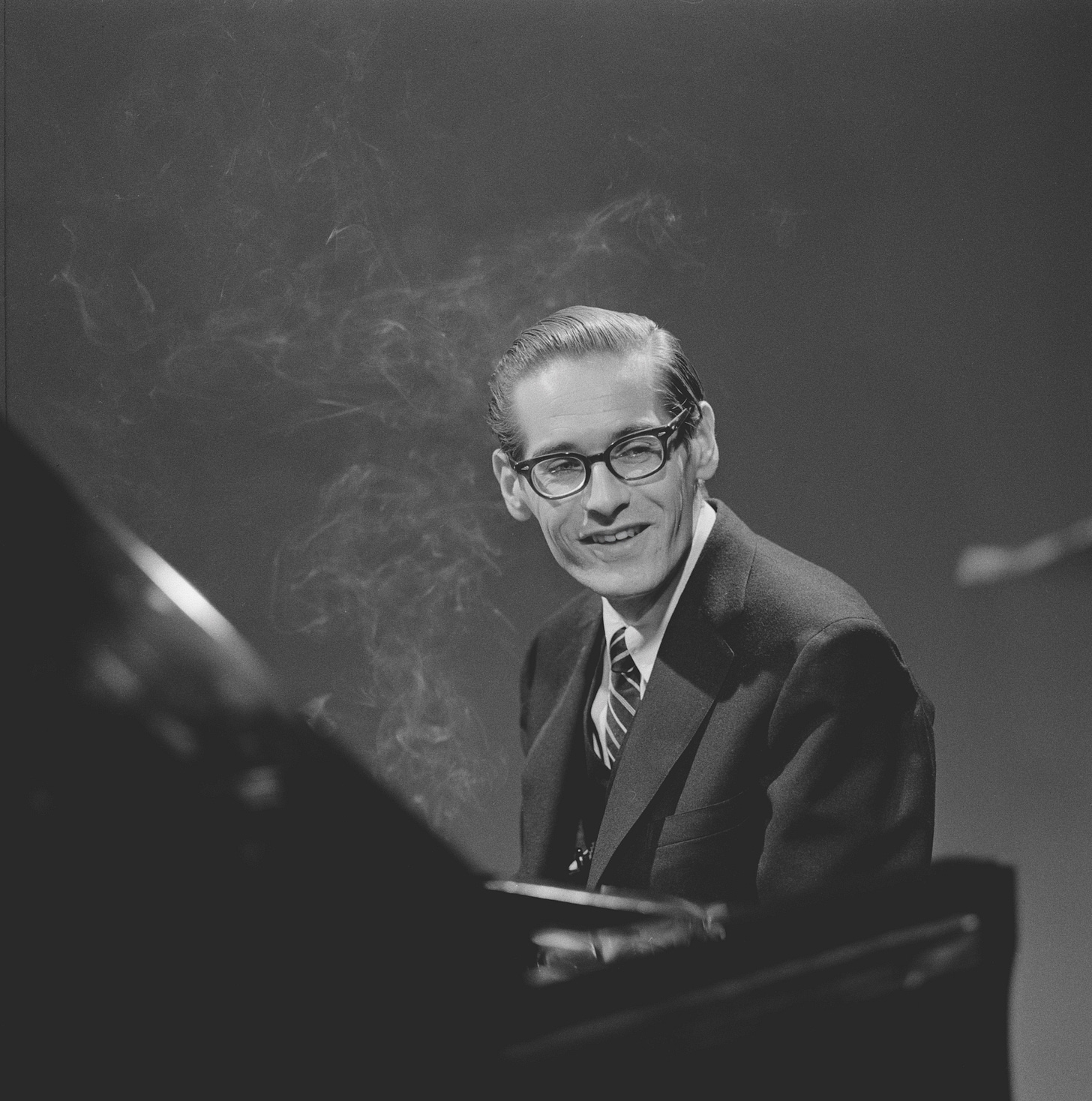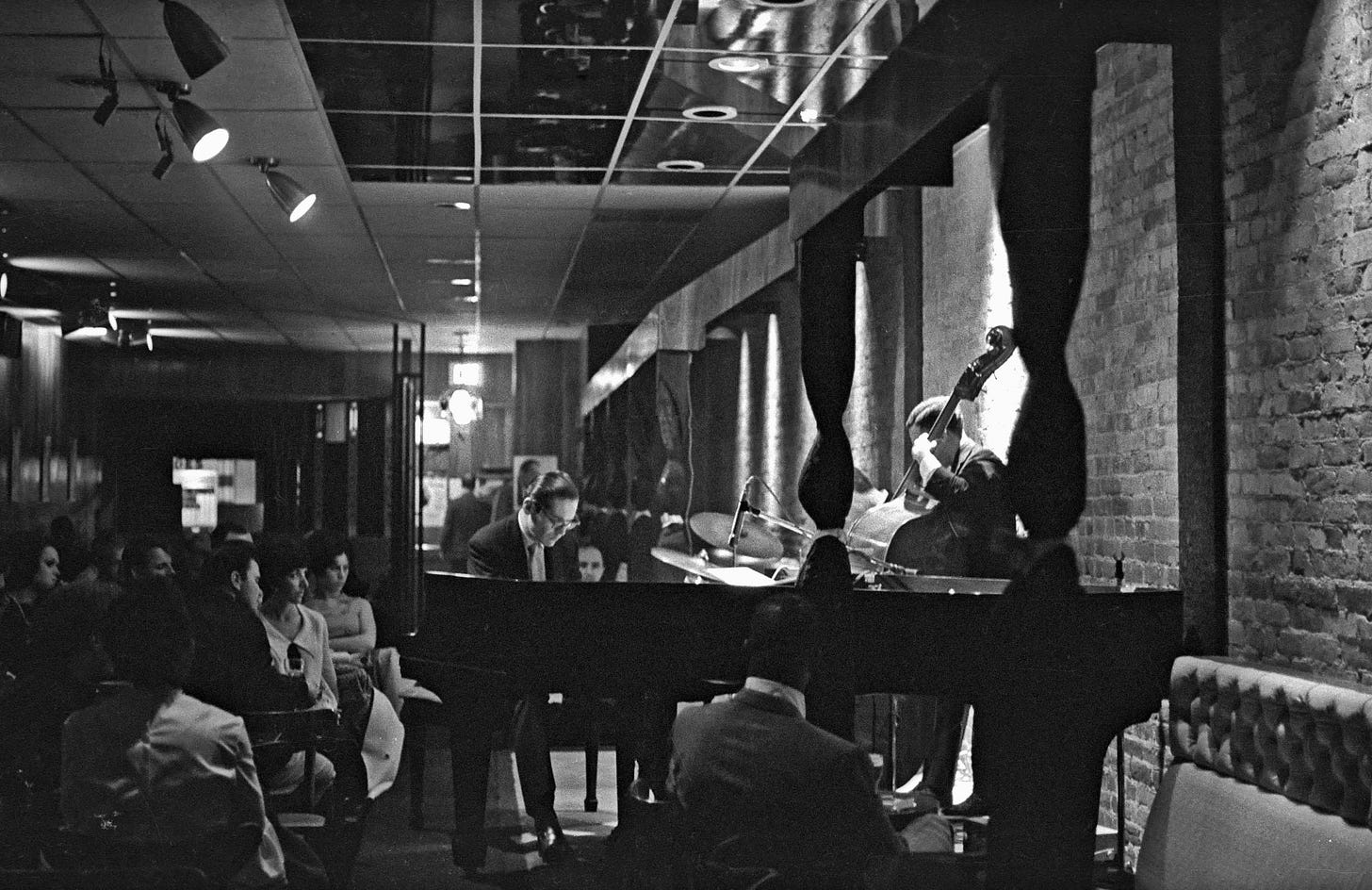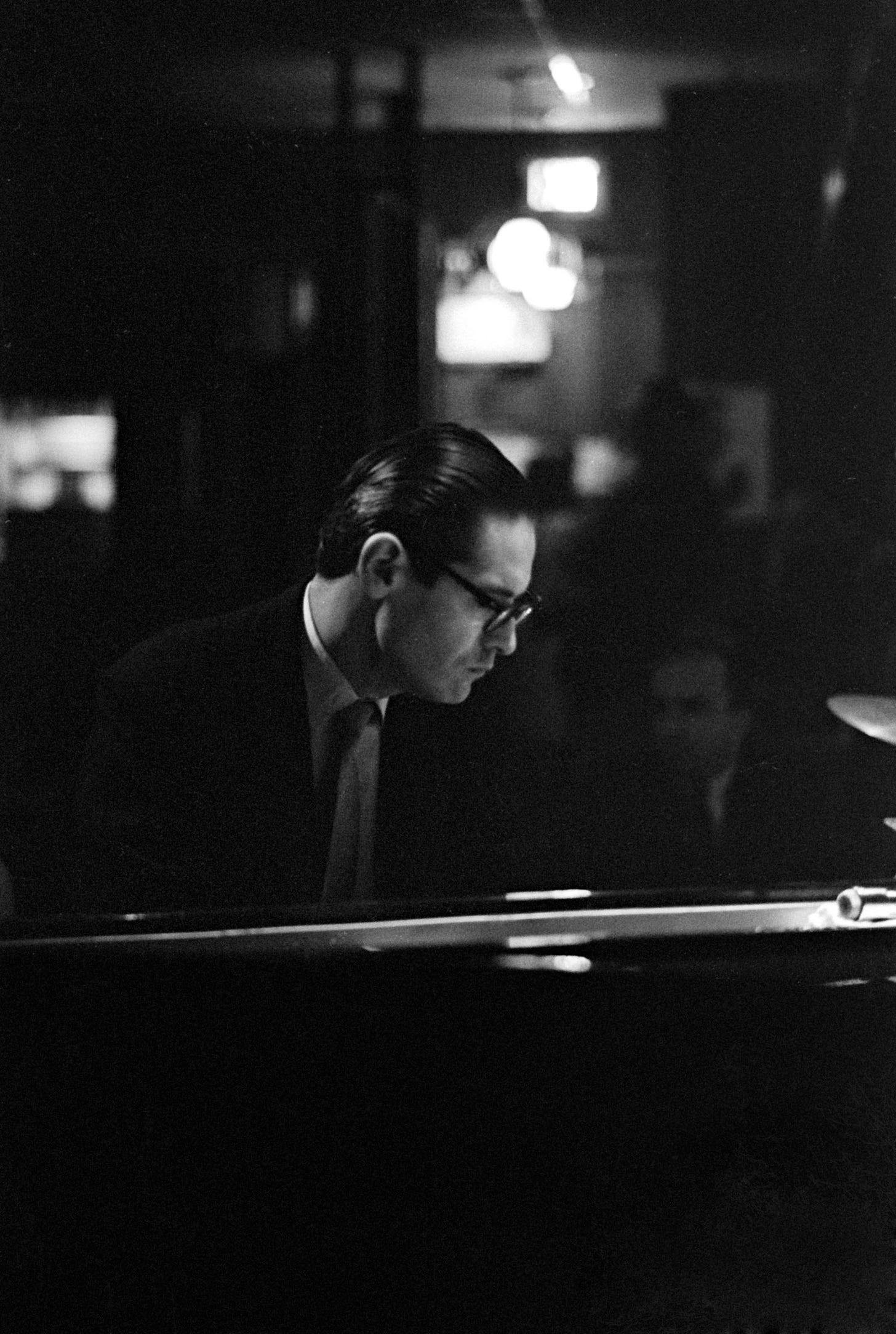After bassist Chuck Israels and drummer Larry Bunker departed the Bill Evans Trio in early 1966, pianist Bill Evans hired bassist Eddie Gómez and drummer Joe Hunt in April of that year for his working group. [Photo above of Bill Evans by Jean-Pierre Leloir]
Their first tour together began that month, starting with a run at Chicago’s London House. Then they moved northwest, stopping for an extended stay in Seattle at the Penthouse jazz club before heading south along the California coast. At the Penthouse, radio host Jim Wilke broadcast the trio live, running radio tape during the performance.
Joe Hunt has not been interviewed at length about his stay in the trio in 1966 and part of ‘67, so it was gratifying for me to do so for my liner notes accompanying the new album, Bill Evans: Portrait at the Penthouse (Resonance).
The double-LP release will be available at local vinyl retailers this Friday, Nov. 28, on Record Store Day. A two-CD set and digital download will follow on Dec. 5 (go here). The music is remarkable.
Some have argued that Evans on these releases miraculously unearthed by producer Zev Feldman feature the same tracks being performed over and over again. I would politely disagree. While the titles may be the same, Evans is all about mood and touch, and each release features a slightly different Evans—relaxed at times, measured at others or edgy and hurried. Ultimately, all music by Bill Evans is worthy and pure gold.
I think what I’ll do now is share a bunch of the opening paragraphs of my liner notes so you have a feel for the drama and music coming in the new release:
Mr. In-Between Gets His Due
By Marc Myers ©
When radio host Jim Wilke recorded the music on this album at Seattle’s Penthouse jazz club in May 1966, pianist Bill Evans had just started working with bassist Eddie Gómez and drummer Joe Hunt. Just a month earlier, on April 12, Gómez and Hunt had joined Evans for the first time at Chicago’s London House for a two-week tryout. Both musicians came recommended by guitarist Jim Hall, who had just recorded the first half of the “Intermodulation” session with Evans. Hall thought Gómez and Hunt would be ideal for the pianist, having worked with them earlier in the year at Lennie’s on the Turnpike just outside of Boston and then at New York’s Village Vanguard. So the album you’re holding is not only the first known recording of this trio but also Evans’s first known recording with Gómez, who would remain with Evans for 11 years, until 1977.
By the time Gómez arrived for his first gig with Evans in Chicago, the 21-year-old bassist had come up through the Newport Festival Youth Band, attended Juilliard and recorded with pianist Paul Bley, the Jazz Composers Orchestra and the New York Art Quartet. Hunt, at age 28, had worked and recorded extensively with George Russell, Don Friedman and Stan Getz. Evans was 36 and had led two celebrated trios—the first with bassist Scott LaFaro and drummer Paul Motian, and the second with bassist Chuck Israels and drummer Larry Bunker. As Israels told me for these notes, he left the trio in March 1966 to study with composer-pianist Hall Overton. Bunker, he added, departed at around the same time to be at home in Los Angeles with his wife, who was caring for her ill father. Bunker also wanted to stay put and earn a steady, solid living there as a first-call studio musician, Evans needed replacements.
“Prior to Chicago, I had met Bill a couple of times,” Hunt recalled in an interview for these liner notes. “Chuck Israels and I had played together in the summer of 1960, backing clarinetist Tony Scott and Bill in concert at Indian Hill, a music camp Chuck’s parents ran in Stockbridge, Mass. That summer, Chuck also introduced me to Bill’s new album “Portrait in Jazz.” Four years later, I recorded for Verve with Bill and Chuck, when I was in the Stan Getz Quartet with Gary Burton. We recorded only three songs. The chemistry wasn’t great and the tracks have never been released.” [Photo above of the Bill Evans Trio by David Azoze]
After the Chicago tryout run in 1966, the new trio set out on a multi-month tour with stops along the way to the Pacific Northwest before they headed south along the coast to Los Angeles. The 10-day Penthouse engagement in May came early in the tour, and the new trio required an adjustment along the way. “Eddie and I had some exposure to free jazz and brought that open feel to our playing, especially Eddie on his solos,” Hunt recalls. “Bill wasn’t a fan of free jazz and initially didn’t know how to accompany Eddie’s free-feel solos. At this point, Bill didn’t play much during Eddie’s solos, so I became a facilitator—a Mr. In-Between, if you will—laying down straight-ahead rhythms that let Bill figure out how to sneak in with chords as Eddie soloed using flurries of notes.”
Downtime collaboration was key. Roommates on the road, Gómez and Hunt would play together in hotel rooms. “I’d take my brushes and play on a wastebasket, and we’d practice together. Eddie is such a fantastic musician, he’d listen like a hawk and even cover my mistakes. We got pretty good at playing together, allowing us to work in tandem without Bill. Then it was just a matter of me giving Bill a rhythmic pathway during gigs to meet Eddie’s approach until he grew accustomed to it.” [Photo above of Bill Evans by David Azoze]
That path was gradual, with Evans wondering from his piano bench if the two musicians were going to work out. In this regard, Gómez and Hunt’s hotel-room jams were essential, since their survival hung in the balance. “At the London House, I felt that Eddie and I were under Bill’s microscope. I’d never played gigs in a piano trio before, so it was tough. In Chicago, if Bill liked what he heard, he’d chime in with chords and a few notes. If he wasn’t happy, there would be silence. So if I heard nothing from him, I figured I was on the wrong track.”
Evans adapted to Gómez gradually, Hunt recalls. At first, he didn’t play at all during the bassist’s solos. “Little by little, Bill figured out what to do, cautiously, and began to accompany him with chords and then added notes. By the time we reached the Penthouse, Bill was more comfortable.” Hunt was familiar with the club, having played there with Getz. “It was a friendly space with brick walls, a great sound and cool management. Audiences listened intently and reacted. By contrast, the London House was a steak place where audiences had been noisy. Bill had to tell them to be quiet one night, which was rare.”
You can buy the LP at local retailers that sell vinyl. For a store near you, type in your Zip Code here. Or you can buy the CD or digital download here.
Here’s a mini doc…
And here’s I Should Care…






Another great release from Resonance Records I'm really looking forward to. I'll buy the CD release. So, day one of waiting till Dec. 5th. 🙂 And thanks of sharing a portion of your liner notes here, Marc. 👍
Beautiful work Marc.